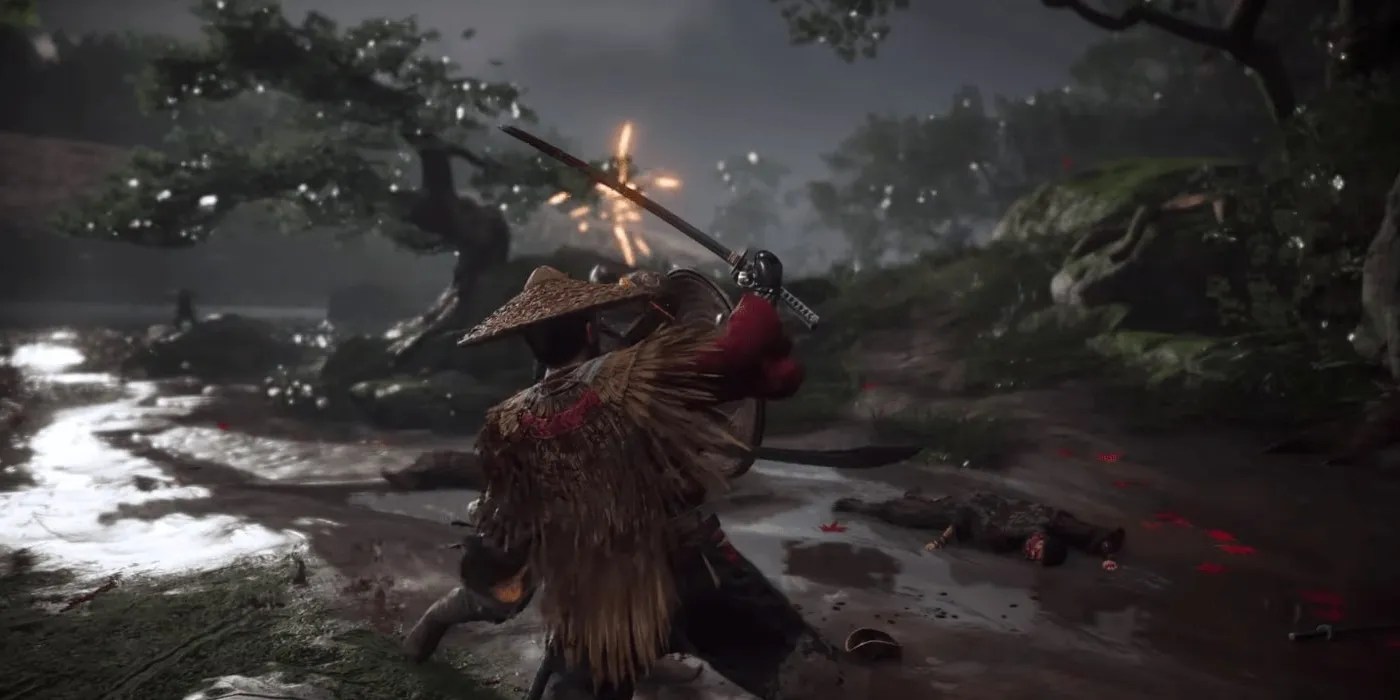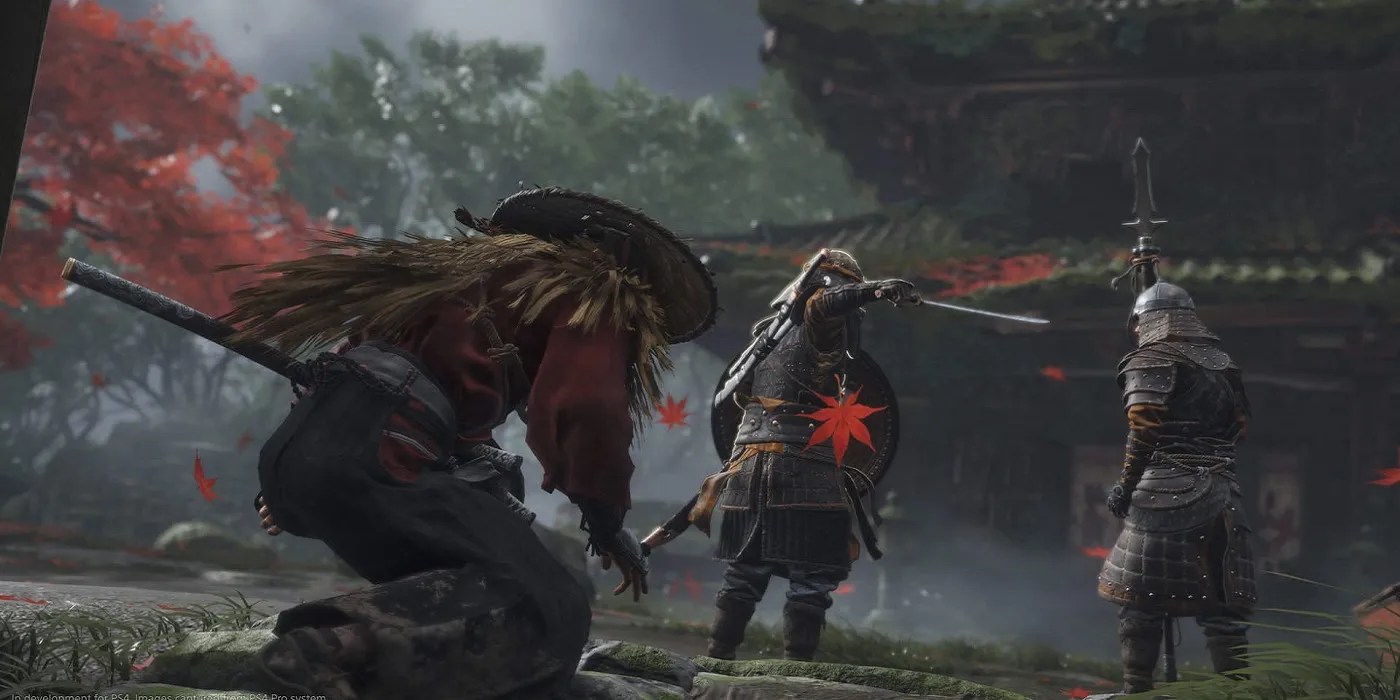Ghost of Tsushimais out now for the PlayStation 4, and the game is shaping up to be one of the biggest titles to be released this year.Ghost of Tsushimahas received mostly positive reviewsfrom players and critics, with many praising its vast open-world environment, immersive story, and engaging combat mechanics.
However, some players pointed out one particular part of the game’s combat system, which does not include a lock-on mechanic. Of course, veteran players of action-adventure games would know that most games that are similar toGhost of Tsushimaprovide players the ability to lock-on to specific enemies, which can be convenient when dealing with multiple foes. So why didGhost of Tsushimadump this popular feature? And why it is not necessarily a bad thing?

RELATED:Will Ghost of Tsushima Come to PS5?
Why Ghost of Tsushima Doesn’t Have A Lock-On Feature
Immediately after some players noticed the lack of a lock-on feature,Ghost of Tsushima’snarrative director, Nate Fox, quicklyexplained why Sucker Punch decided not to include the specific mechanic.According to Fox, the lack of a lock-on feature was intentional to remain faithful to the samurai films that inspired the game. “Well working on the combat, we watched samurai films, which are of course an inspiration for the feeling of this game,” Fox said. “And the fighters in those movies will often have to switch their attention very fluidly from one incoming foe to another. So the combat is built around dealing with a variety of enemies, a group of them.”
Additionally, Fox noted that while the player will face other enemies inGhost of Tsushima,players will primarily fight against Mongolsand Sucker Punch wanted these enemies to be like a wolf pack that would surround the player. Based on the developer’s statement, it appears that the decision not to include a lock-on feature is primarily because the team wanted players to have an authentic and immersive experience, which encourages them to use their skills when fending off multiple enemies at once.

Why The Lack of a Lock-On Feature is a Good Thing
In the context ofGhost of Tsushima, which is set in feudal Japan and revolves around the story of samurai Jin, the lack of a lock-on mechanic makes sense given thatthe developers were trying to capture the feel of samurai filmthat heavily inspired the game. As mentioned by Fox, Sucker Punch wanted players to approach combat in a more fluid manner by being mindful of enemies coming from all sides. Not only does this make combat more challenging, but it also provides players with an authentic experience especially when compared to the samurai warriors that are depicted in films.
Of course, in the context of whether or not it is a good idea to drop the lock-on mechanic forother action games, it appears that the lack of this feature is not a bad idea. The reason for this is that players will be relying solely on their skills to dodge multiple enemies while trying to land critical hits to specific enemies. This also encourages players to strategize their approach to combat, and not rely on the lock-on mechanic to target specific foes.

Additionally, not having a lock-on mechanic aalows players to move quickly between opponents, making combat more fluid and efficient. This is because having the lock-on mechanic present in the game would prevent players from improvising during the heat of battle and efficiently respond to simultaneous threats. In the end, the lack of a lock-on mechanic inGhost of Tsushimaallows players to have more control over how they should approach combat,encouraging players to use skillrather than approaching it like just another hack and slash game.
RELATED:Ghost of Tsushima: Komatsu Forge Enemies and Yellow Bird Explained
Should Other Games Follow Ghost of Tsushima’s Example?
As previously mentioned, the primary reason whyGhost of Tsushimadecided to dump the lock-on mechanic is to emulate the samurai films that inspired it. However, even without that context, it appears that the removal of the lock-on feature could also be beneficial to other games that are similar toGhost of Tsushima, given that players would have to rely on skill to survive an ambush from multiple enemies. So should other games follow suit?
Well, that really depends on how a developer designs a certain game’s combat system. InGhost of Tsushima, the lack of a lock-on mechanic worked, given thatthe developers designed the combat system to be harderand favor a more spontaneous approach to every enemy encounter. However, for games such asDragon Agefor example, where players are given a wide plethora of skills and abilities to use, the lock-on feature is essential, if not necessary. Games in this format would usually have certain skills where enemies would either take more damage or be resistant to. Given this, the lock-on mechanic is important so that players can properly use specific abilities that would prove more efficient in dealing with different enemy types.
Nonetheless, despite some players feeling uncomfortable withGhost of Tsushima’slack of a lock-on mechanic, it is evident thatthe game was designed without the feature in mind. According to Fox, the team seesGhost of Tsushima’scombat like a dance where players would have to flawlessly switch between multiple enemies to execute the most kills with the least damage possible. In the end, whether or not other games should followGhost of Tsushima’scombat system remains to be seen, but one thing that players should take away from this is that the removal of the lock-on feature inGhost of Tsushimais a good thing.
MORE:Ghost of Tsushima and Sekiro Similarities Shown in New Video